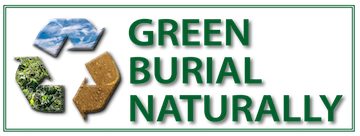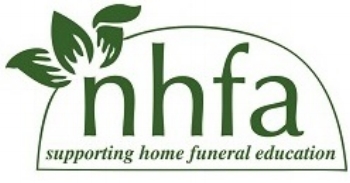Sometimes synergy manifests out of nowhere yet when it's examined, you see roots you missed before everything was pulled together.
Over the past year as I've reached out to sell The Natural Burial Cemetery Guide the market I thought would be there for it--cemeteries and funeral homes--never materialized. Instead, energy and excitement generated from an unexpected quarter: alternative afterdeath caregivers.
Anne Jungerman, home funeral guide and inspiration for Tulocay Cemetery's green burial project; Veronica, my roommate; and me, at the NHFA conference.
I understood quickly why these caregivers would be an appropriate audience; they could use the guide in their work, and cemeteries, though I thought they would put the book in their public spaces for bragging rights, wouldn't necessarily spread the word about other natural burial cemeteries.
But it wasn't until the National Home Funeral Alliance biennial conference that I understood the profound connection between natural/home funeral care and natural/green burial.
It took my father's death for it to sink in that burial or cremation alone doesn't constitute afterdeath care. What happens between death and disposal (an unlovely term that encompasses both the above options)?
By not talking about it our death-phobic culture has lost the language to define what happens after death. Because of this, the most foolproof way to get from death to disposition is to call your local funeral home, though even this act becomes difficult for someone who hasn't thought anything about death--where IS the local funeral home and do I just call up?
What will the funeral home do? It'll pick up the body and transport it to premises where it can be prepared for cremation, or washed, embalmed, made-up, dressed, laid out in a chosen casket, and driven to the cemetery for burial. Paperwork will be filed, a funeral ceremony designed and executed. All for a fee--you can argue the fee is too high but not argue that like any American business, the funeral home needs a profit to survive.
It makes sense to a green burial advocate that someone choosing green burial would want their body handled through this phase in an appropriate way and not embalmed before joining the earth.
For those who address death ahead of time, the conventional route can be exited at some point or bypassed entirely. This is where home funeral guides come in. (I'm not talking here about death doulas, whose alternative to conventional care starts before death.) Home funeral guides help families arrange things after death so that some or all of the tasks are under their control. This may not be for everyone; the thought of physically caring for my father's body after his death didn't appeal, though I could imagine getting to that point myself, perhaps with my husband's body. My father was left in the care of a funeral director who is a strong advocate for green burial, and had the facilities to wash, keep him without embalming, to shroud him and transport him to the burial ground.
NHFA board for the new biennium.
Yet these are actions that throughout human history have been performed by family or community, and we have allowed to become institutionalized. The NHFA website lists guides who will "work to empower families and friends to care for their own dead...The NHFA believes that families and friends can and should do as much as they are able, because this is what is most natural and healing."
The atmosphere at the conference was electric with caring, healing, excitement about the work of the caregivers and the supporters and advocates. This energy drew me into recognizing a conundrum: After caring for a dead body in a natural way are you really going to want to bury it in a conventional manner? Doubtful. An obvious alternative to conventional burial is cremation, but cremation is often a default solution as it's pretty readily available. If you don't want to burn up the body you've cared for in life and death, green or natural burial is the obvious alternative. Unfortunately, it's not readily available everywhere. I put together the cemetery guidebook because information on green burial cemeteries is time-consuming to track down. As a society we are no better informed about our cemeteries than we are about funeral homes and for the same reason. Home funeral guides who want to help families carry through the process to this conclusion need to have access to knowledge about it ahead of time. The Green Burial Council is also an excellent place to find out more information. If you know where cemeteries are, you can educate yourself on what their options really mean. A grieving family is unlikely to stumble upon green burial without prior knowledge. A home funeral guide in possession of options--and preferably with connections to make them happen locally--can best serve clients right to the end.




